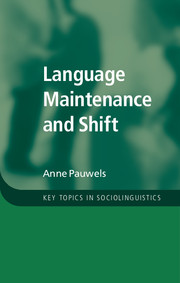Book contents
- Frontmatter
- Dedication
- Contents
- Acknowledgements
- Introduction
- PART I HISTORY, CONCEPTS, CONTEXTS AND APPROACHES
- PART II INVESTIGATING LANGUAGE MAINTENANCE AND SHIFT: COLLECTING AND ANALYSING DATA
- PART III IDENTIFYING AND UNDERSTANDING TRENDS AND PATTERNS IN THE DYNAMICS OF LANGUAGE MAINTENANCE AND SHIFT
- PART IV LANGUAGE MAINTENANCE EFFORTS AND REVERSING LANGUAGE SHIFT
- PART V FUTURE DEVELOPMENTS IN THE STUDY OF LANGUAGE MAINTENANCE AND SHIFT
- References
- Index
- References
Introduction
Published online by Cambridge University Press: 05 August 2016
- Frontmatter
- Dedication
- Contents
- Acknowledgements
- Introduction
- PART I HISTORY, CONCEPTS, CONTEXTS AND APPROACHES
- PART II INVESTIGATING LANGUAGE MAINTENANCE AND SHIFT: COLLECTING AND ANALYSING DATA
- PART III IDENTIFYING AND UNDERSTANDING TRENDS AND PATTERNS IN THE DYNAMICS OF LANGUAGE MAINTENANCE AND SHIFT
- PART IV LANGUAGE MAINTENANCE EFFORTS AND REVERSING LANGUAGE SHIFT
- PART V FUTURE DEVELOPMENTS IN THE STUDY OF LANGUAGE MAINTENANCE AND SHIFT
- References
- Index
- References
Summary
Writing a book on language maintenance and language shift in the second decade of the twenty-first century poses some interesting challenges. The term ‘language maintenance’ evokes both a sense of ‘stability’ and a level of abstraction that may seem increasingly at odds with the linguistic realities characterising many communities and societies around the world. These new realities are best described as highly dynamic, with constantly and rapidly changing language constellations. As a result, a range of new terms has surfaced to describe these hyperdynamic language situations, including hyperlingualism (Pauwels 2014), metrolingualism (Otsui and Pennycook 2010) and many more variations along these lines. The term ‘language maintenance’ has had limited currency in the description of societies where multilingualism was or is the norm for communication among individuals: most African and many Asian communities would be prime examples of such communities. The term ‘language maintenance’ has been and continues to be used extensively in the context of societies where only specific sectors of the community (e.g., immigrants, indigenous minorities) engage in bi- or multilingual practices, sometimes only for a limited period of time. These sectors of the community were and are the ones facing questions of maintaining their ‘home’, ‘heritage’, ‘ethnic’, ‘community’ language in light of competition from the language(s) of the new environment and/or of the linguistic majority. It is this second group of communities and societies, i.e., those in which only sectors of the population engage in multilingual practices, that has changed and continues to change quite dramatically in terms of linguistic constellations. Most pronounced are the linguistic changes observed in (large) urban settings: such environments are now characterised by a panoply of languages and a growing number of plurilingual speakers for whom the question of language maintenance would be quite complex or perhaps even futile, as they engage, often daily, in communicative practices that draw upon various languages rather than just two. In some respects these ‘new’ linguistic realities and new communicative practices found in a growing number of ‘western’ urban settings or in westernised societies increasingly resemble the multilingualisms found in parts of Africa or Asia.
- Type
- Chapter
- Information
- Language Maintenance and Shift , pp. 1 - 6Publisher: Cambridge University PressPrint publication year: 2016
References
- 1
- Cited by

